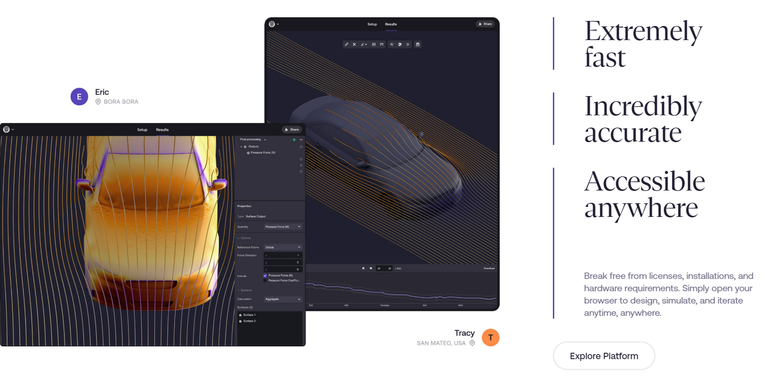Luminary Cloud - GPU and Cloud combined to accelerate product analysis and design process
Google DeepMind | Unsplash
We may have gotten used to using technologies that we don't really know how they work. Behind them, there is hard work of excellence and the purest precision so that the risk of errors is minimized to the maximum.
It is common to imagine ourselves on a flight to another city or country and enjoy the trip, but there was a group of experts who have done their best so that you can travel comfortably and safely.
Behind all technology there is a physics that allows its function, such as the aerodynamics of a commercial airplane. It is also present in sports vehicles, because if you want to improve speed, acceleration, and other parameters that make it much faster, this is taken into account when creating a prototype.
What comes to mind at this very moment are the events in which we are shown prototypes, which once tested and approved, will be launched to the public, although many ideas will remain there only as an exhibition and may never aspire to mass production, or maybe yes in future occasions and attempts to introduce them to the world. At this point, I think we have missed several interesting things to try.
Why are we talking about all this? Well, simulations are a very important process in engineering. It is a test in which reality is simulated and has been a stage considered crucial for the launch of the final product.
Just as there is physical simulation, there is also virtual simulation or done through complex computational processes that determine the performance of each of the parts affected by different factors such as wind, water, pressure, temperature.

From Luminary Cloud site
Perhaps the current problem is that these processes are too slow and also have a high cost. This is where Luminary Cloud comes in, a startup that offers a very interesting proposal to solve these inconveniences.
The main problem is that there is legacy software that is not updated to modern technology that requires cloud access and GPU execution. This software is probably decades old, so this startup offers a platform to perform engineering simulations using the latest technologies.
Clients such as Puma, Cobra Golf, and Joby Aviation are using these tools to carry out various tests on different scenarios to enhance the capabilities of the product and optimize their designs.
As we mentioned earlier, the time that is reduced thanks to the way the cloud and a GPU interact with each other on the platform greatly reduces the simulation and analysis time, and therefore their results. We are talking about a reduction from weeks to a few minutes, so it is a very interesting option.
The benefits seem to be many and they result in improved productivity, increased speed leading to relevant (real-time) results, and a reduction in costs because there is no charge for a license or subscription but payment is for the use of the GPU measured in minutes; the moment the simulation and analysis are done.
Lango, the founder of Luminary, mentions that a simple airplane simulation could last a few minutes and end up costing less than $90, but he also adds that, in the case of more important simulations, either because they are more numerous or because they are larger in scale, they would fall into what are discounts for prepaid capacity.
An important aspect to consider, especially in modern times, is artificial intelligence. Luminary Cloud has an assistant called Lumi AI, which allows for the automatic generation of meshes. Very useful for analyzing each of the parts that interact with a 3D object, for example, to analyze its aerodynamics.
With the inclusion of AI, the simulation and analysis process will lead to obtaining data from which significant elements can be extracted that represent value for the user. In my opinion, we are facing a platform that could be above its competition in the following years due to the features it offers.
The company raised 15 million dollars and another 100 million dollars in debt from Sutter Hill with intentions to expand the organization and enhance the capabilities of its product, which is currently focused on providing next-generation cloud-based engineering simulation.
- Main image edited in Canva.
- I have consulted information in techcrunch.com.
- I have used Hive Translator to translate from Spanish to English.
Posted Using InLeo Alpha
Luminary Cloud emerges as a game-changer by blending GPU power with cloud flexibility. This innovative platform accelerates product analysis and design, offering professionals a seamless, efficient way to bring their ideas to life. It's an exciting development for creators looking to enhance productivity and creativity. With Nebius AI's cloud platform https://nebius.ai/, the leap to utilizing NVIDIA® H100 Tensor Core GPUs was not just a step, but a giant leap towards efficiency and innovation. What struck me most was not just the platform's cutting-edge technology, but its surprisingly competitive pricing, making such powerful computing accessible without breaking the bank.
The dedicated support team behind Nebius AI deserves a shoutout for their relentless assistance, making my experience smooth and enjoyable. Their guidance helped me navigate through the platform's features with ease, enhancing my overall user experience.
Financial flexibility is another cornerstone of Nebius AI, offering significant savings through resource reservation and committed use discounts. This aspect has been a game-changer for my projects, allowing me to allocate funds more strategically while still harnessing high-performance computing capabilities.